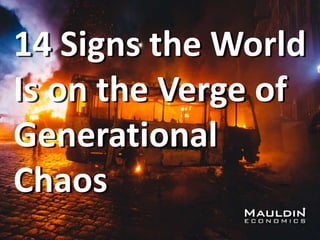14 Signs the World Is on the Verge of Generational Chaos
- 1. 14 Signs the World is on the Verge of Generational Chaos
- 2. In 1997, Neil Howe and William Strauss introduced the concept of Fourth Turning.
- 3. They divided the population into four generational archetypes: Hero, Artist, Prophet, and Nomad.
- 4. Each generation consists of people who were born and came of age at the same period in history.
- 5. They had similar experiences and thus gravitated toward similar attitudes.
- 6. The change of control from one generation to the next is called a “turning”.
- 7. On a Fourth Turning, the cycle repeats, sparking a generational crisis.
- 8. When Howe uses that word, he doesn’t mean a short period of difficulty.
- 9. He means an existential crisis— one in which society’s strongest institutions collapse and national survival is in serious doubt.
- 10. When Howe uses that word, he doesn’t mean a short period of difficulty.
- 11. He means an existential crisis— one in which society’s strongest institutions collapse and national survival is in serious doubt.
- 12. By Neil Howe’s timeline, we are today about halfway through the Fourth Turning’s Crisis phase.
- 13. If this Fourth Turning is like previous ones, here is what we should see…
- 16. See how the following Fourth Turning characteristics match today’s landscape…
- 17. Join Hundreds of Thousands of Readers of John Mauldin’s Free Weekly Newsletter Follow Mauldin as he uncovers the truth behind, and beyond, the financial headlines in his free publication, Thoughts from the Frontline. Free Instant Access
- 18. Rising Community
- 19. Think of all the disasters we have seen in recent times, and the public response to them.
- 20. Following the recent tragic events in Baton Rouge, Minneapolis, and Dallas, communities have drawn together to support their members and each other.
- 21. We see the same behavior in other stressful events, eg “Je suis Charlie,” the motto that emerged from the January 2015 Paris shootings.
- 23. We live in a time when most voters would rather enlarge government than shrink it.
- 24. We can expect to see stronger government action regardless of who wins this year’s presidential election.
- 26. Donald Trump is envisions changing the Republican Party into something quite different than it was just four years ago, a “workers’ party”.
- 27. We will see a lot of shifting and movement between the two parties as they redefine themselves.
- 29. Fifteen years in, the US is increasingly tired of the War on Terror.
- 30. Donald Trump gained traction in the primaries with a less aggressive approach to foreign engagement.
- 32. The Internet has entered adulthood. It’s become a platform on which to build new capabilities: virtual reality, home automation, and more.
- 34. The years of ZIRP (zero interest rate policy) and QE (quantitative easing) served mainly to drive up asset prices, enriching those who are already wealthy and doing little for everyone else.
- 35. Now a backlash is building against wealth concentration.
- 36. We may see attempts to raise taxes on the wealthy, higher working-class wages, and other measures intended to “level the playing field.”
- 37. Wage Disruption
- 38. We’ve seen major retailers hike hourly pay in the last year; $15/hour minimum wages passed in California and elsewhere; and there are growing calls for labor to get a bigger piece of the pie.
- 39. Fertility Bust
- 40. Birth rates are now near or even significantly below replacement rate throughout the developed world.
- 41. Much of the Millennial Generation feels financially or otherwise unprepared for parenthood.
- 43. Both the US and Europe are trying to control immigrant flows. Refugees from the Middle East are the exception in an otherwise less migratory world.
- 44. Falling Crime
- 45. Criminal activity varies tremendously depending on where you are, but overall rates are down considerably from the 1980s and 1990s.
- 47. This one may seem counterintuitive with birth rates down and young people reluctant to marry.
- 48. It actually seems that people delay marriage today precisely because they respect it so much. They want to do it right or not at all.
- 49. And once Millennials do have kids, they take parenting very seriously. As the Hero archetype, Millennials amazingly protective of their children.
- 51. The financial crisis has set a new standard of frugality.
- 52. Think “sharing” economy, like Uber and Airbnb, and “fast fashion” like Zara or H&M.
- 54. The Fourth Turning is a time when people rediscover values and norms.
- 55. That process can take many shapes, of course, but we may again see the “all-together” ethos that brought the US through the Depression and World War II.
- 57. Today’s cautious parents won’t let children out of their sight—and often with good reason.
- 58. As the crisis unfolds, we should see growing concern for protecting children from harm.
- 59. The Worst Is Yet to Come
- 60. Neil How says we are only halfway through; and if the next few years play out like past Fourth Turnings, the worst is yet to come.
- 61. The good news is that we still have some time. We can prepare our lives to deal with the coming changes.
- 62. Join Hundreds of Thousands of Readers of John Mauldin’s Free Weekly Newsletter Follow Mauldin as he uncovers the truth behind, and beyond, the financial headlines in his free publication, Thoughts from the Frontline. Free Instant Access






























































